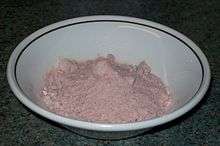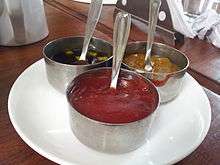Kala namak
Kala namak is a kiln-fired rock salt used in South Asia with a sulphurous, pungent-smell. It is also known as "Himalayan black salt", Sulemani namak, bit lobon, kala noon, or pada loon and manufactured from the salts mined in the regions surrounding the Himalayas.
.jpg) Large pieces of kala namak salt | |
| Alternative names | Black salt |
|---|---|
| Region or state | South Asia Himalayan regions |
The condiment is composed largely of sodium chloride with several other components lending the salt its colour and smell. The smell is mainly due to its sulfur content. Because of the presence of Greigite (Fe3S4, Iron(II,III) sulfide) in the mineral, it forms brownish pink to dark violet translucent crystals when whole. When ground into a powder, its color ranges from purple to pink.
Kala namak has been praised in Ayurveda and used for its perceived medical qualities.[1][2]
Production
The raw material for producing kala namak was originally obtained from natural halite from mines in Northern India and Pakistan in certain locations of the Himalayas salt ranges,[3][4] or from salt harvested from the North Indian salt lakes of Sambhar or Didwana.[5]
Traditionally, the salt was transformed from its relatively colourless raw natural forms into the dark coloured commercially sold kala namak through a reductive chemical process that transforms some of the naturally occurring sodium sulfate of the raw salt into pungent hydrogen sulfide and sodium sulfide.[6] This involves firing the raw salts in a kiln or furnace for 24 hours while sealed in a ceramic jar with charcoal along with small quantities of harad seeds, amla, bahera, babul bark, or natron.[5][6] The fired salt melts, the chemical reaction occurs, and the salt is then cooled, stored, and aged prior to sale.[7][3] Kala namak is prepared in this manner in northern India with production concentrated in Hisar district, Haryana.[6] The salt crystals appear black and are usually ground to a fine powder that is pink.
Although the kala namak can be produced from natural salts with the required compounds, it is common to now manufacture it synthetically. This is done through combining ordinary sodium chloride admixed with smaller quantities of sodium sulfate, sodium bisulfate and ferric sulfate, which is then chemically reduced with charcoal in a furnace. Reportedly, it is also possible to create similar products through reductive heat treatment of sodium chloride, 5–10% of sodium carbonate, sodium sulfate, and some sugar.[6]
Composition
Kala namak consists primarily of sodium chloride and trace impurities of sodium sulfate,[8][9] sodium bisulfate, sodium bisulfite, sodium sulfide, iron sulfide and hydrogen sulfide.
Sodium chloride provides kala namak with its salty taste, iron sulfide provides its dark violet hue, and all the sulfur compounds give kala namak its slight savory taste as well as a highly distinctive smell, with hydrogen sulfide being the most prominent contributor to the smell. The acidic bisulfates/bisulfites contribute a mildly sour taste.[4] Although hydrogen sulfide is toxic in high concentrations, the amount present in kala namak used in food is small and thus its effects on health are negligible.[4] Hydrogen sulfide is also one of the components of the odor of rotten eggs and spoiled milk.[10]
Uses

Kala namak is used extensively in South Asian cuisines of India, Pakistan, Bangladesh and Nepal as a condiment or added to chaats, chutneys, salads, all kinds of fruits, raitas and many other savory Indian snacks. Chaat masala, an Indian spice blend, is dependent upon black salt for its characteristic sulfurous hard-boiled-egg aroma. Those who are not accustomed to black salt often describe the smell as similar to rotten eggs.[1]
Kala namak is considered a cooling spice in Ayurveda and is used as a laxative and digestive aid.[3][8][9][11] It is also believed to relieve flatulence and heartburn. It is used in Jammu to cure goitres.[11] This salt is also used to treat hysteria and for making toothpastes by combining it with other mineral and plant ingredients.[3]
See also
- Black lava salt
- Himalayan salt
References
- Moorjani, Lachu (2005), Ajanta: Regional feast of India, Gibbs Smith, p. 22, ISBN 978-1-58685-777-6
- Case, Frances (6 June 2008), 1001 Foods You Must Eat Before You Die, Cassell Illustrated, ISBN 978-1-84403-612-7
- Bitterman, Mark (2010), Salted:A Manifesto on the World's Most Essential Mineral, with Recipes, Random House of Canada, pp. 166–167
- Vorkommen von Schwefelwasserstoff in "Schwarzsalz" (PDF), Bundesinstitut für Risikobewertung (BfR), 25 August 2003
- Chandrashekhar, D (22 February 1977), Maqsood Mohammad vs The State Of Uttar Pradesh And Anr. on 22 February 1977, Allahabad High Court
- Chandra, S (18 February 1970), Commissioner, Sales Tax vs Balwant Singh Jag Roshan Lal on 18 February 1970, Allahabad High Court
- Sher Ali Tiwana (5 December 2016), How black salt is made on big scale, retrieved 12 February 2019
- Ali, Z. A. (August 1999), "Folk veterinary medicine in Moradabad District (Uttar Pradesh), India", Fitoterapia, 70 (4): 340–347, doi:10.1016/S0367-326X(99)00039-8
- Sadhale, Nalini; Nene, Y L (2004), "On Elephants in Manasollasa – 2. Diseases and Treatment", Asian Agri-History, 8 (2): 115–127
- Harold McGee (2004). On Food and Cooking (2nd ed.). Scribner. ISBN 978-0684800011.
- Aggarwal, Hemla; Kotwal, Nidhi (2009), "Foods Used as Ethno-medicine in Jammu", Studies on Ethno-Medicine, 3 (1): 65–68
